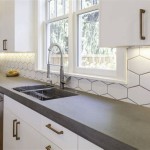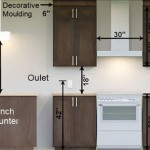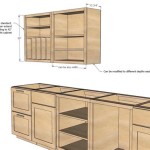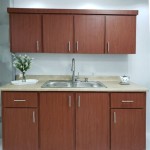Kitchen Cabinet Size and Dimension Essentials: A Guide to Plan Your Dream Kitchen
Designing a functional and aesthetically pleasing kitchen involves careful planning, including the selection of kitchen cabinets. The sizes and dimensions of these cabinets play a pivotal role in determining the overall layout, storage capacity, and functionality of your kitchen. To ensure a well-designed and harmonious space, it's essential to understand the key aspects of kitchen cabinet sizes and dimensions.
Standard Cabinet Widths
Kitchen cabinets come in various widths, with standard increments of 3 inches. Common widths include:
- 12 inches: Suitable for narrow spaces, such as above the refrigerator
- 15 inches: Ideal for wall cabinets and pantry cabinets
- 18 inches: A versatile width for base and wall cabinets
- 21 inches: Provides ample storage for dishes and cookware
- 24 inches: Common width for both base and wall cabinets, offering generous storage
Base Cabinet Heights and Depths
Base cabinets typically measure 34.5 inches in height, including the countertop. The standard depth for base cabinets is 24 inches, providing sufficient space for storage and appliances.
Wall Cabinet Heights and Depths
Wall cabinets are typically shorter in height, ranging from 12 inches to 42 inches. Standard depths for wall cabinets are 12 inches and 15 inches. These dimensions allow for easy accessibility and maximize storage capacity.
Toe Kick Heights
Toe kicks are the recessed area at the bottom of base cabinets that provides space for your feet. Standard toe kick heights range from 3.5 inches to 6 inches, allowing for comfortable use and protecting the cabinet base from damage.
Determining the Correct Cabinet Sizes
To determine the optimal cabinet sizes for your kitchen, consider the following factors:
- Available space: Measure the width, height, and depth of the intended cabinet location.
- Storage needs: Assess the amount and types of items you need to store in the cabinets.
- Appliance requirements: Ensure the cabinets can accommodate any appliances, such as ovens or dishwashers.
- Ergonomics: Consider the height and reach of users to determine the most comfortable cabinet heights.
Designing for Cabinetry Variations
In addition to standard sizes, cabinets can be customized to accommodate unique kitchen designs and requirements. These variations may include:
- Corner cabinets: Designed to maximize space efficiency in corners, available in various configurations.
- Tall cabinets: Offer additional storage capacity and can be used for pantry items or appliances.
- Island cabinets: Provide extra storage and counter space in kitchen islands.
- Specialty cabinets: Custom-made cabinets to meet specific storage or aesthetic needs, such as wine racks or appliance garages.
Conclusion
Understanding kitchen cabinet sizes and dimensions is essential for planning a functional and visually appealing kitchen. By carefully considering the standard dimensions, determining the appropriate sizes for your space, and exploring possible variations, you can create a harmonious and efficient kitchen that meets your unique needs and preferences.

Base Cabinet Size Chart Builders Surplus

Wall Cabinet Size Chart Builders Surplus

Kitchen Wall Cabinet Size Chart Builders Surplus Cabinets Sizes Dimensions

N Standard Kitchen Dimensions Renomart

Woodcraft Custom Kitchen Cabinet Measurements

Kitchen Cabinet Sizes What Are Standard Dimensions Of Cabinets

Kitchen Cabinet Sizes And Specifications 2024 Stock Cabinets Corner Base

Measure Your Kitchen Cabinets Before Designing The Layout

Get Perfect Kitchen Cabinet Measurements With These 5 Easy Steps

Kitchen Unit Door Combinations
Related Posts








